What started out as a lark, a delightful romp down the Potomac River on board the Navy’s sparkling new warship, turned into a bloody tragedy on 28 February 1844, when a huge gun exploded on the deck of the U.S.S. Princeton, killing eight people including two Secretaries from President John Tyler’s Cabinet. The cannon Peacemaker had successfully been fired twice earlier on the cruise and was supposedly done for the day, but Secretary of the Navy Thomas Gilmer – who became one of the fatalities – insisted the gun be fired a third time to impress the guests, and Captain Robert F. Stockton reluctantly agreed.

The U.S.S. Princeton was a revolutionary warship. Designed by Swedish-born inventor John Ericsson, the ship was the Navy’s first steamship powered by a screw propeller instead of a paddlewheel, and carried the two largest guns in the Navy arsenal. These gigantic weapons, called the Oregon and the Peacemaker, were 12-inch cannons that could fire a 225-pound cannonball 5 miles using a 50-pound charge of gunpowder.
Ericsson designed the Oregon with a revolutionary technique involving wrapping red-hot iron hoops around the breech to strengthen it to withstand the powerful gunpowder charges. Captain Stockton supervised construction of the matching gun Peacemaker, except he did not follow Ericsson’s hoop design and simply thickened the size of the gun’s breech, a decision that would prove fatal.
The Princeton arrived in Washington, D.C., on 13 February 1844, and during the next week made three cruises with members of Congress and other important guests to show off her speed and demonstrate the power of her two guns, especially Stockton’s pride, the Peacemaker. Then, on February 28, the big gala performance was scheduled.
Over 400 guests were invited, including President Tyler, Secretary of State Abel B. Upshur, Secretary of the Navy Thomas W. Gilmer, former First Lady and leading Washington socialite Dolley Madison, many other dignitaries, and their wives and families. It was a beautiful, warm late-February day, much mingling and socializing occurred, the guests were awed when the Peacemaker was twice fired, and by mid-afternoon everyone was down below deck enjoying an exquisite lunch of fine food and fancy wines and champagne.
Then Secretary Gilmer requested that the Peacemaker be fired a third and final time, and guests trooped up on deck for the exhibition. President Tyler was on his way up when he paused on the ladder to hear his son-in-law finish singing a song.
If not for that pause he surely would have been standing alongside his two Cabinet Secretaries, who were blown apart when the gun’s breech exploded. The Peacemaker disaster was a gruesome spectacle, with heads, limbs, and other body parts blown off and strewn about the bloody deck. Along with the 8 deaths, 20 other people were injured, some quite badly. A delightful day filled with lightness and gaiety had suddenly turned tragic, and the whole country mourned.
Along with the disaster on that day, the explosion aboard the Princeton almost had a second devastating impact on the nation. Even though Captain Stockton had supervised construction of the Peacemaker, John Ericsson was blamed for the terrible accident aboard the revolutionary ship he had designed and built. He became so embittered by his treatment that he distrusted the U.S. Navy and almost was unwilling to work with it 17 years later, when his even more revolutionary design for the Navy’s first iron-clad warship, the U.S.S. Monitor, was built, ultimately saving the blockading Union fleet during the Civil War’s Battle of Hampton Roads.
Here is a transcription of this article:
MOST AWFUL AND MOST LAMENTABLE CATASTROPHE!
Instantaneous Death, by the Bursting of One of the Large Guns on Board the United States Ship Princeton, of Secretary Upshur, Secretary Gilmer, Commodore Kennon, & Virgil Maxcy, Esq.
In the whole course of our lives it has never fallen to our lot to announce to our readers a more shocking calamity – shocking in all its circumstances and concomitants – than that which occurred on board the United States Ship Princeton, yesterday afternoon, whilst under way, in the river Potomac, fourteen or fifteen miles below this city.
Yesterday was a day appointed, by the courtesy and hospitality of Capt. Stockton, Commander of the Princeton, for receiving as visitors to his fine ship (lying off Alexandria) a great number of guests, with their families, liberally and numerously invited to spend the day on board. The day was most favorable, and the company was large and brilliant, of both sexes; not less probably in number than four hundred, among whom were the President of the United States, the Heads of the several Departments, and their families. At a proper hour, after the arrival of the expected guests, the vessel got under way and proceeded down the river, to some distance below Fort Washington. During the passage down, one of the large guns on board (carrying a ball of 225 pounds) was fired more than once, exhibiting the great power and capacity of that formidable weapon of war. The Ladies had partaken of a sumptuous repast; the gentlemen had succeeded them at the table, and some of them had left it; the vessel was on her return up the river, opposite to the fort, where Captain Stockton consented to fire another shot from the same gun, around and near which, to observe its effects, many persons had gathered, though by no means so many as on similar discharges in the morning, the ladies who then thronged the deck being on this fatal occasion almost all between decks, and out of reach of harm.
The gun was fired. The explosion was followed, before the smoke cleared away so as to observe its effect, by shrieks of woe which announced a dire calamity. The gun had burst, at a point three or four feet from the breech, and scattered death and desolation around. Mr. Upshur, Secretary of State, Mr. Gilmer, so recently placed at the head of the Navy, Commodore Kennon, one of its gallant officers, Virgil Maxcy, lately returned from a diplomatic residence at The Hague, Mr. Gardner, of New York (formerly a Member of the Senate of that State), were among the slain. Besides these, seventeen seamen were wounded, several of them badly and probably mortally. Among those stunned by the concussion, we learn not all seriously injured, were Capt. Stockton himself; Col. Benton, of the Senate; Lieut. Hunt, of the Princeton; W. D. Robinson, of Georgetown. Other persons also were perhaps more or less injured, of whom, in the horror and confusion of the moment, no certain account could be obtained. The above are believed, however, to comprise the whole of the persons known to the Public who were killed or dangerously or seriously hurt.
The scene upon the deck may more easily be imagined than described. Nor can the imagination picture to itself the half of its horrors. Wives, widowed in an instant by the murderous blast! Daughters smitten with the heart-rending sight of their father’s lifeless corpse! The wailings of agonized females! The piteous grief of the unhurt but heart-stricken spectators! The wounded seamen borne down below! The silent tears and quivering lips of their brave and honest comrades, who tried in vain to subdue or to conceal their feelings! What words can adequately depict a scene like this?
The bodies of the killed remained on board the ship last night. They will be brought to the city this morning.
Note: An online collection of newspapers, such as GenealogyBank’s Historical Newspaper Archives, is not only a great way to learn about the lives of your ancestors – the old newspaper articles also help you understand American history and the times your ancestors lived in, and the news they talked about and read in their local papers.
